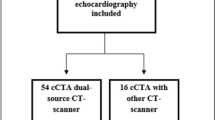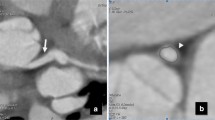Abstract
Kawasaki disease (KD) related coronary artery (CA) aneurysms may lead to significant and potentially insidious progressive stenosis. It is also well recognized that CA scarring leads to heavy calcification in KD. We intended to correlate the angiographic anomalies associated with coronary calcifications in KD and to evaluate the chronology and the detection rate of KD-related CA calcification on plain chest X-ray. Between 1992 and 2006, 65 CA angiograms were performed in 50 KD patients. Chest fluoroscopies and angiograms were retrospectively reviewed. When angiograms were abnormal, chest X-rays were reviewed by two radiologists blinded to the results of angiograms. CA lesions were identified in 18/50 (36%) patients, including isolated CA aneurysms in 10. All 8 patients who had CA aneurysms associated with stenosis and/or occlusion had CA calcification identifiable on chest X-ray. All significant stenotic lesions were concomitant with calcification. Plain chest X-ray, a simple inexpensive low dose mean, easily identifies KD patients at risk for serious CA stenosis when specific search for CA calcification is pursued. When detected, a closer tracking of coronary artery patency is warranted via other imaging techniques, usually expensive, invasive, requiring sedation in children or exposing to high radiation.



Similar content being viewed by others
References
Akagi T, Ogawa S, Ino T, Iwasa M, Echigo S, Kishida K, Baba K, Matsushima M, Hamaoka K, Tomita H, Ishii M, Kato H (2000) Catheter interventional treatment in Kawasaki disease: a report from the Japanese Pediatric Interventional Cardiology Investigation Group. J Pediatr 137:181–186
Arnold R, Ley S, Ley-Zaporozhan J, Eichhorn J, Schenk JP, Ulmer H, Kauczor HU (2007) Visualization of coronary arteries in patients after childhood Kawasaki syndrome: value of multidetector CT and MR imaging in comparison to conventional coronary catheterization. Pediatr Radiol 37:998–1006
Burns JC, Shike H, Gordon JB, Malhotra A, Schoenwetter M, Kawasaki T (1996) Sequelae of Kawasaki disease in adolescents and young adults. J Am Coll Cardiol 28:253–257
Dadlani GH, Gingell RL, Orie JD, Roland JM, Najdzionek J, Lipsitz SR, Pieroni DR, Lipshultz SE (2005) Coronary artery calcifications in the long-term follow-up of Kawasaki disease. Am Heart J 150:1016
Dahdah N, Ibrahim R, Cannon L (2007) First recanalization of a coronary artery chronic total obstruction in an 11-year-old child with Kawasaki disease sequellae using the crosser catheter. Pediatr Cardiol 28(5):389–393
Dajani AS, Taubert KA, Takahashi M, Bierman FZ, Freed MD, Ferrieri P, Gerber M, Shulman ST, Karchmer AW, Wilson W (1994) Guidelines for long-term management of patients with Kawasaki disease. Report from the Committee on Rheumatic Fever, Endocarditis, and Kawasaki Disease, Council on Cardiovascular Disease in the Young, American Heart Association. Circulation 89:916–922
Fujiwara H, Hamashima Y (1978) Pathology of the heart in Kawasaki disease. Pediatrics 61:100–107
Fukuda M, Nishiya H (1982) Chest roentgenographic findings and ultrasonographic findings of gallbladder in Kawasaki disease. Jpn J Pediatr Med 14:260–261
Ikeda K, Sato N, Sakuma Y, Tetsuya T (1986) Three cases of MCLS associated with calcification of the coronary arteries on the chest X-ray. J Clin Pediatr 34:63–69
Ino T, Shimazaki S, Akimoto K, Park I, Nishimoto K, Yabuta K, Tanaka A (1990) Coronary artery calcification in Kawasaki disease. Pediatr Radiol 20:520–523
Ino T, Nishimoto H, Iwahara M, Abe M, Nittono H (1993) Lateral view of chest X-ray in long-term follow-up of Kawasaki disease as a useful screening method for cardiac sequela. Acta Paediatr Jpn 25:48–54
Kato H, Sugimura T, Akagi T, Sato N, Hashino K, Maeno Y, Kazue T, Eto G, Yamakawa R (1996) Long-term consequences of Kawasaki disease. A 10- to 21-year follow-up study of 594 patients. Circulation 94:1379–1385
Nakada T, Yonesaka S, Sunagawa Y, Tomimoto K, Takahashi T, Matsubara T, Furukawa H, Kamimura K, Naka S (1991) Coronary arterial calcification in Kawasaki disease. Acta Paediatr Jpn 33:443–449
Nakamo H, Ueda K, Saito A, Nojima K (1985) Repeated quantitative angiograms in coronary arterial aneurysm in Kawasaki disease. Am J Cardiol 56:846–851
Nakamura Y, Aso E, Yashiro M, Uehara R, Watanabe M, Oki I, Yanagawa H (2008) Mortality among persons with a history of Kawasaki disease in Japan: mortality among males with cardiac sequelae is significantly higher than that of the general population. Circ J 72:134–138
Nakatani S, Uema T, Yoshimo M (1982) Two cases of Kawasaki disease associated with calcification of the coronary arteries on the chest-X-ray. J Pediatr Pract 45:2059
Newburger JW, Takahashi M, Gerber MA, Gewitz MH, Tani LY, Burns JC, Shulman ST, Bolger AF, Ferrieri P, Baltimore RS, Wilson WR, Baddour LM, Levison ME, Pallasch TJ, Falace DA, Taubert KA; Committee on Rheumatic Fever, Endocarditis, and Kawasaki Disease, Council on Cardiovascular Disease in the Young, American Heart Association (2004) Diagnosis, treatment, and long-term management of Kawasaki disease: a statement for health professionals from the Committee on Rheumatic Fever, Endocarditis and Kawasaki Disease, Council on Cardiovascular Disease in the Young, American Heart Association. Circulation 110:2747–2771
Peng Y, Zeng J, Du Z, Sun G, Guo H (2009) Usefulness of 64-slice MDCT for follow-up of young children with coronary artery aneurysm due to Kawasaki disease: Initial experience. Eur J Radiol 69(3):500–509
Rozin L, Koehler S, Shakir A, Ladham S, Wecht CH (2003) Kawasaki disease: a review of pathologic features of stage IV disease and two cases of sudden death among asymptomatic young adults. Am J Forensic Med Pathol 24:45–50
Tanaka N, Naoe S, Masuda H, Ueno T (1986) Pathological study of sequelae of Kawasaki disease MCLS. With special reference to the heart and coronary arterial lesions. Acta Pathol Jpn 36:1513–1527
Tsuda E, Kamiya T, Ono Y, Kimura K, Kurosaki K, Echigo S (2005) Incidence of stenotic lesions predicted by acute phase changes in coronary arterial diameter during Kawasaki disease. Pediatr Cardiol 26:73–79
Author information
Authors and Affiliations
Corresponding author
Rights and permissions
About this article
Cite this article
Lapierre, C., Bitsch, A., Guérin, R. et al. Follow-Up Chest X-Ray in Patients with Kawasaki Disease: The Significance and Clinical Application of Coronary Artery Macro-Calcification. Pediatr Cardiol 31, 56–61 (2010). https://doi.org/10.1007/s00246-009-9548-5
Received:
Accepted:
Published:
Issue Date:
DOI: https://doi.org/10.1007/s00246-009-9548-5




